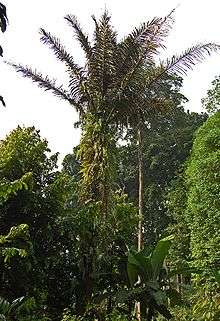Arenga pinnata
| Arenga pinnata | |
|---|---|
 | |
| Scientific classification | |
| Kingdom: | Plantae |
| Clade: | Angiosperms |
| Clade: | Monocots |
| Clade: | Commelinids |
| Order: | Arecales |
| Family: | Arecaceae |
| Genus: | Arenga |
| Species: | A. pinnata |
| Binomial name | |
| Arenga pinnata | |
Arenga pinnata (syn. Arenga saccharifera) is an economically important feather palm native to tropical Asia, from eastern India east to Malaysia, Indonesia, and the Philippines in the east.[1] Common names include sugar palm, arenga palm, areng palm, black-fiber palm, and gomuti palm.
It is a medium-sized palm, growing to 20 m tall, with the trunk remaining covered by the rough old leaf bases. The leaves are 6–12 m long and 1.5 m broad, pinnate, with the pinnae in 1–6 rows, 40–70 cm long and 5 cm broad. The fruit is subglobose, 7 cm diameter, green maturing black.[2]
It is not a threatened species, though it is locally rare in some parts of its range. It serves as an important part of the diet of several endangered species, including cloud rats of the genus Phloeomys.

Uses
Sap
The sap is harvested for commercial use in southeast Asia, yielding a sugar known in India as gur or in Indonesia as gula aren. The sap is collected and made as lahang, a traditional cold sweet drink, and is also fermented into vinegar and tuak palm wine.
Edmund Roberts talks about drinking an alcoholic beverage made in the Cavite area. He described it as a "fermented" and "intoxicating liquor." He said that it was "the pith furnished with sugar – when the liquor was properly boiled down, a farina...and of the inside of its triangular-shaped fruit a sweetbread was made."[3]
The raw juice and pulp are caustic. This crop may develop into a major resource of biofuel (ethanol).
Fruit
The immature fruits are widely consumed in the Philippines (called kaong) and Indonesia (called buah kolang-kaling or buah tap) and are made into canned fruits after boiling them in sugar syrup.
Fibres

The dark fibrous bark (known as doh in India) is manufactured into cordage. In Indonesia the black fibres surrounding the trunk, called ijuk fibres, are used as the organic roof material common in Indonesian vernacular architecture. According to the study on bas-reliefs of Javanese ancient temples such as Borobudur, this type of roof are known in ancient Java vernacular architecture. It can be found today in Balinese temple roof architecture and Minangkabau Rumah Gadang gonjong horn-like curved roof architecture, such as those found in Pagaruyung Palace. The ijuk fibres can also be made into rope, used in brooms, or used as filters to clear the water.
Legend
According to Sundanese folklore, the spirit known as Wewe Gombel dwells in the Arenga pinnata palm, where she also has her nest and keeps the children she abducts.[4]
See also
Notes
- ↑ Uhl, Natalie W. and Dransfield, John (1987) Genera Palmarum – A classification of palms based on the work of Harold E. Moore. Lawrence, Kansas: Allen Press. ISBN 0-935868-30-5 / ISBN 978-0-935868-30-2
- ↑ Riffle, Robert L. and Craft, Paul (2003) An Encyclopedia of Cultivated Palms. Portland: Timber Press. ISBN 0-88192-558-6 / ISBN 978-0-88192-558-6
- ↑ Roberts, Edmund (1837). Embassy to the Eastern Courts of Cochin-China, Siam, and Muscat. New York: Harper & Brothers. p. 59.
- ↑ Wewe Gombel Archived 2012-08-23 at the Wayback Machine.
References
| Wikimedia Commons has media related to Arenga pinnata. |